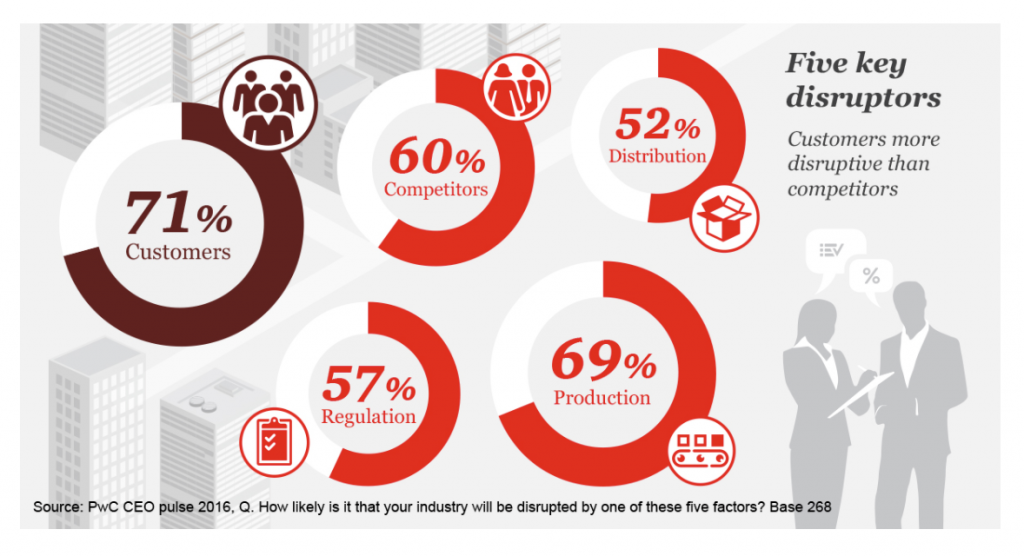We live in an age of disruption. An age where disruption is the new normal and disruptive forces are everywhere- reinventing and threatening the way we do business. The only thing more threatening than the disruption itself is its pace and devastating effect on organizational lifespan.
Innosight reveals that the average lifespan of S&P 500 companies is expected to shrink from 33 years in 1965 to 14 years by 2026. About half of the S&P 500 companies today are expected to be replaced over the next 10 years.
Organizations know this. Yet are not prepared for it. Accenture reports that 93% of companies anticipate unexpected disruption but only 20% are highly prepared for it.
Most lack preparation partly because it can be challenging to address disruptions when they come from multiple sources like large scale disruptors (Amazon, Google) to startups (Uber, AirBnb, Spotify), and/or new technologies (IoT, AI, blockchain). But a deeper look at these disruptors begs several questions:
How do you prioritize among these diverse sources of disruptions? Are they even the biggest disruptors in today’s world? And if not, is there another source of disruption out there that may be more powerful and perhaps is not getting as much attention, but should?
It turns out, there is. And it may surprise you. It’s your customer. According to a PWC CEO survey, customers are the biggest disrupters to an organization.

The survey goes on to say that customer-driven disruption is transforming commerce at a global scale. Which raises the question: How can you prepare for it? Before we can answer that, we need to first understand how customers are driving disruption in the first place.
They want you when they need you
Every new product, service, and experience heightens customer expectation. And makes them want cheaper, faster, and better products and services. And superior experiences. For example, with personalized ride-hailing, Uber popularized the on-demand personalized service model. And customers started expecting it in other aspects of life. Which resulted in the Uberization of other industries such as grocery delivery (e.g., Instacart), vacation rental (e.g., AirBnb), and private luxury travel (e.g., Surf Air).
They want you to meet their unique needs
As customer needs evolve, they want products, services, and experiences that are unique and personalized. Leading brands recognize this. And are responding. Starbucks offers 80,000 drink combinations. Pizza Hut offers more than two billion possible flavor combinations. New Balance, a global athletic leader, takes customization to a whole new level — allowing customers to create their own custom shoes.
They want you to amplify who they are
Customers want to associate with brands that are more than their products and services. They want brands to reflect their values and amplify their personal identity and lifestyle in a positive manner. Take the case of Under Armour. Customers associate with them not just for their athletic apparel but also for the healthy lifestyle they promote.
This brings us back to our original question: How do you prepare for our leading disruptor – the customer?
Be customer centric
One of the reasons Amazon has been so successful at what it does is because of an obsession with being customer centered. From offering one-click purchases to free same-day delivery to easy returns, and even shipping boxes that can be reused, Amazon puts customer at the center of everything it does.
The brand’s obsession with customer-centricity has paid off. Amazon, with $356B market value in 2016, gained 1,934% in market value in the past 10 years, outdoing all the major big brick-and-mortar retailers.
Which raises the question: how do you build a customer-centric culture?
It starts at the top with a clear customer strategy and a C-level person to champion it. But that’s just the start. You need to supplement it with several tactical actions. This includes, but is not limited to aligning BU-level strategies with the broader customer strategy; training employees for customer success; reinforcing the back-end with the right technologies; and empowering your partners and suppliers to strengthen the customer relationship.
Anticipate and fulfill customer needs
While Amazon may be the poster child of a customer driven company, other companies, including traditional retailers, have taken notice. Take Walmart, for example. Walmart leverages 40+ Petabytes of data from 200 data streams to make real-time decisions on sales, supply, and inventory management. And uses the data along with sensor product data to anticipate future customer orders.
How do you build an organization that is able to do this?
You need to start by collecting the right customer data. Connect the disparate streams of customer data to get a single view of the customer. And then use it to drive customer insights and relevant decisions. Finally, you need to setup your technology and analytics stack to facilitate rapid decision making.
Be agile
In the age of disruption, organizational agility is critical. Agile organizations respond to changing customer behavior faster, better, and cheaper. By doing so, they not only survive but thrive during disruptions.
How can your organization be agile?
First, quickly adopt disruptive innovations that fulfil customer needs, transform their expectations and drive value. For example, by adopting Twitter and Instagram early, Starbucks was able to develop a much larger social footprint compared to its competition (3x that of Dunkin’ Donuts)
Second, embrace a culture of innovation where you are constantly enhancing your value proposition to your customers. Be it through creating new products, services, experiences, or business models. Or, by reinventing yourself through strategic acquisitions like Amazon did with its acquisition of Whole Foods.
Finally, forge strategic partnerships to expand your reach and relevance. And pick ones which strengthen your core business and allow you to pivot to new, unchartered markets. For example, Apple’s partnership with Hermes extended the reach of Apple Watch from techies to fashion-conscious consumers.
Final takeaway
Customer-driven disruptions are inevitable in today’s world. It is critical to understand their source and prepare for them. If you do, not only will you survive and thrive, you will be the disruptor.



